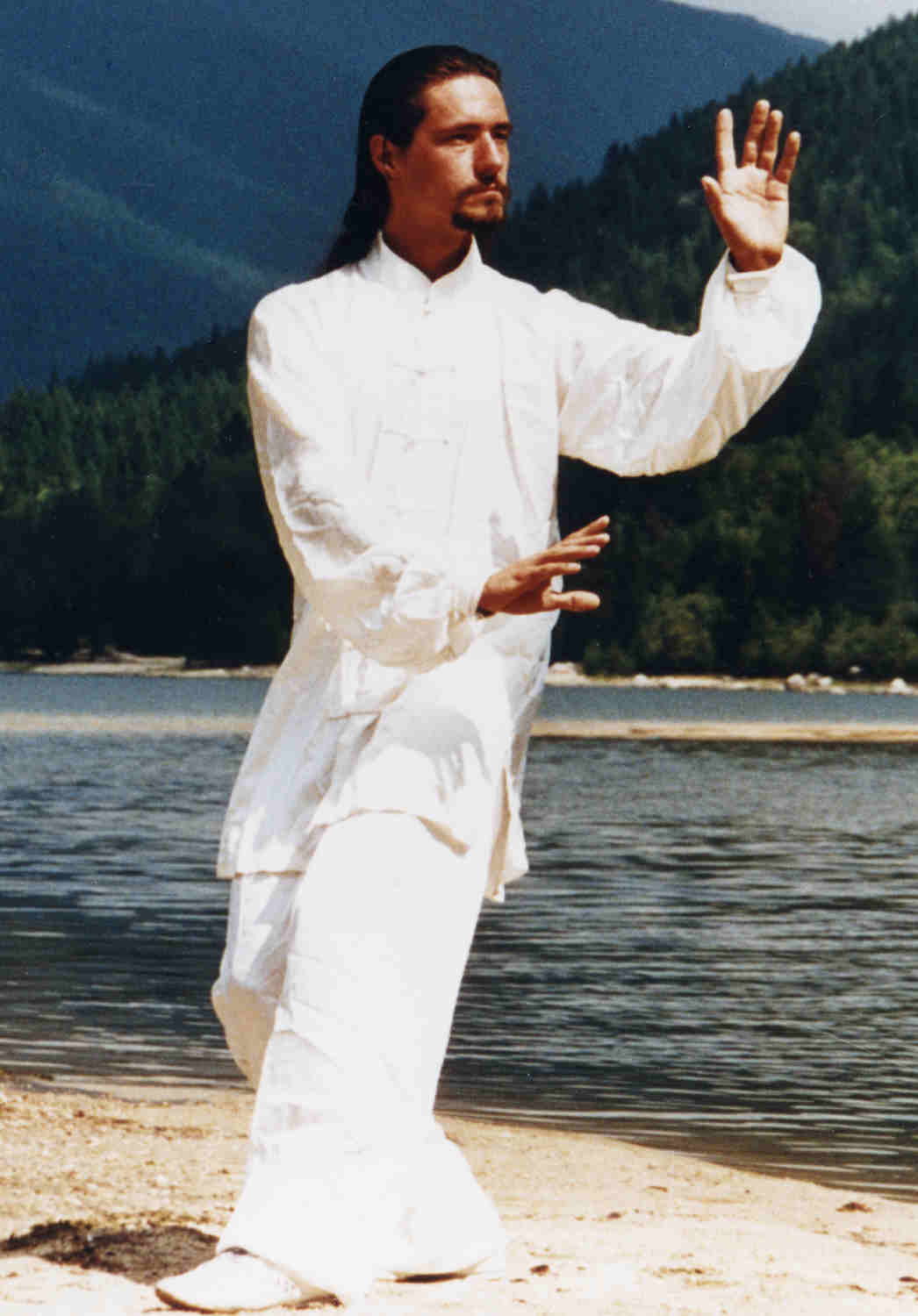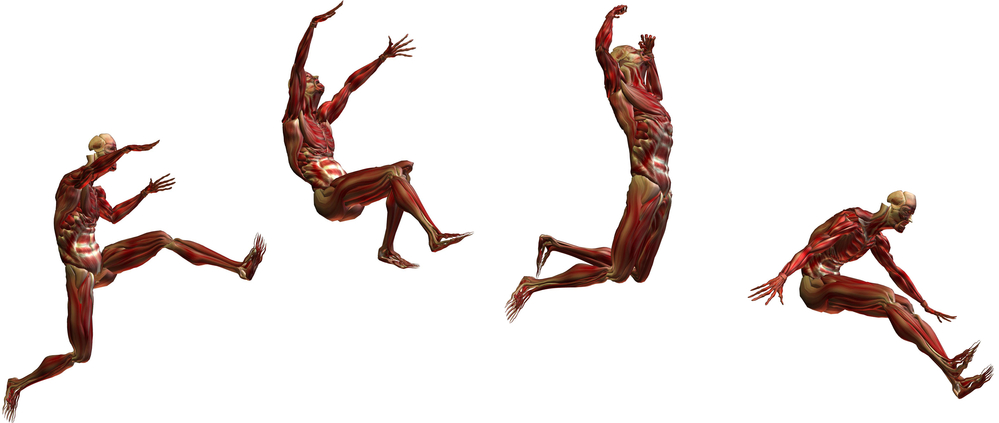The Yi Jin Jing Process
NOTE: If you have not read Part One – The Shaolin Muscle Tendon Change Practice (Yi Jin Jing), please do. This article and the terminology will make more sense.
Just like any skill, the connective tissue transformation and tensegrity process (Yi Jin Jing) begins by learning the necessary tools, skills, practices, and principles.
The first principle to learn is knowing your body on the inside – or developing an Internal Landscape (Nei Jing 內經). Knowing the names of every muscle and bone is less important than the ability to differentiate, contract, and release all of your individual muscles and myofascial systems. Becoming aware of your physical body will also bring your awareness to any imbalances, incompletely healed injuries, or patterns of embodied emotional distress.
Pick a joint, limb, or vertebrae right now, if you are curious, and move it around. Stretch, rotate, push, pull, contract, release, become still, and relax into and through any habitual stiffness. If you could turn that experience into a cartoon map of your tension, or a hologram, or a statue – that is your Inner Landscape.
If you were just moving an ankle, knee, shoulder, elbow, wrist, or waist, you are probably more tangibly in touch with the bones, the angles that can be created by your muscles, and where you feel strong or not. Exploring your range of motion is a great way to learn more about your Landscape.
The next skill is often the most challenging to put into practice. It is about feeling more than doing.
Learning about your Inner Landscape takes some sensitivity and patience, which brings up the Qi Gong skill called Ting Jin 聽勁 – the power of ‘Listening with your whole Body and Being’. If you are new to this part of Qi Gong practice, you can read an article about Ting Jin HERE.
It is important to keep in mind that all of your muscles rely primarily on motor nerves and load-sensing nerves. The way your brain moves your muscles like they are the pullies, and your bones are the levers, does not provide a lot of sensual feedback. Your load-sensing nerves can tell you that you are about to drop something, or cause damage, which is kind of like yelling “Oh No!” Otherwise, your muscles and structure do not have a lot to say – by themselves.
However, your multilayered and highly integrated fascial networks and your interstitial membranes and filaments register about 80% of the actual sensations you experience somatically. Your Jin Jing 筋經 (the contractile aspect of your meridians), or your network of micro-elastic tissues is what actually makes up most of the felt sense of your body, your posture (gravity), your energy level, your emotional and existential state of being, your overall fitness, and, of course, where you have the most limitations, injuries, and/or pain.
We all start at the beginning. We all have to learn to listen on the inside.
Move that shoulder or knee again, feel your membranes carefully and play with your elasticity. Find any tissue ‘cobwebs’ and put it on your Inner Landscape restoration list.
Restoring and realigning your many muscles and membranes requires that you elongate, rotate, reach, and release, in as many different directions as possible, across all of your joints – at the same time. There are many Qi Gong forms to choose from that can facilitate this process, as long as you are training for both coordination and rehabilitation.
Keep in mind that rehabilitation implies returning all of your Jin Jing 筋經 – to their original tissue matrix and/or imitating the underlying fabric of the Universe.

The first form that is usually taught in the Yi Jin Jing system, is the Twelve Gestures of Wei Tuo. Many refer to this form as the Yi Jin Jing form. This form is usually taught first because it challenges and restores several aspects of your coordination.
For context, imagine that you are driving, and for some reason, you suddenly have to turn around and turn off the overhead light that is behind you. If you can imagine that experience, feel into your body. Ting Jin 聽勁…,
Listen and feel into every fibre and the elasticity of your whole body (Jin 筋and Jing經).
Connect with as many different directions, rotations, pressures, and specific aspects of coordination that you are able to, that you would need to do to maintain in that moment, while driving safely, or at least staying in your lane, and at the same time turning, looking quickly, reaching, finding, and turning off the overhead light.
Notice your core as you’re driving along, holding the wheel, keeping your feet on the appropriate pedals, turning away from what you’re doing, using the steering wheel as a leverage point…
What is your core doing when you turn off the light?
Restoring natural coordination through Qi Gong forms is an enjoyable and safe way to explore your elasticity and tone (Jin 筋). As your awareness and listening skills help you map out your Inner Landscape (Nei Jing 內經), you can guide the gradual process of Yi Jin Jing – the transformation of both the contractile tissues and the underlying fascial networks, collagen matrix, and stem cell bank account that maintains and builds your entire body.
As your practice becomes consistent and your body begins to elongate from within, it will be time to focus on your awareness of contraction and release (Jin 筋) through a range of qualities and interactions. Traditionally, there is a very sequential nine-step process of resistance, progressive relaxation, pandiculation, as well as a whole-body opening practice called Pore Breathing, and some subtle state shift practices. That is the Yì 易 or the transformational and restorative part.
You will need to learn this process from a qualified teacher from the Shaolin lineage. Learning this process properly is beyond worth the effort of finding a traditional teacher! It does not take very long for the changes in your muscle tone and pliability to become noticeable – to you and everyone around you.
Before moving on to the next step, I want to bring your attention to an unexpected and important truth. You may need the Yi Jin Jing for the same reason the original Shaolin monks did. Too much sitting. Today we sit and watch screens, in the monastery 1500 years ago, they were sitting and observing – sitting and forgetting…, for many hours of every day!
Fortunately, even if you only learn the Twelve Gestures of Wei Tuo form, you will have a way to connect to and restore all of the meridians and membranes of your body. Each of the 12 exercises not only helps you with coordination and rehabilitating any kind of imbalance, but they also help you develop whole-body sensitivity and agility.
Remember that most of your embodied awareness is experienced through your multi-joint, multi-layered system of fascia. If you know a complete Qi Gong system, the symphony of coordination, sensitivity, and agility, along with some healthy curiosity and playfulness, will also help you develop more fluid and powerful movements. This quality of movement often looks like a person that is not limited by their bones.
Bring your attention back to turning off that light behind you while driving. Now imagine that your arms and legs are becoming a bit like boneless tentacles. How would your feet, hand on the wheel, and hand reaching back feel as they interact with each other across your very pliable spine?
As you invest some time developing your body’s tone and pliability by reaching, pulling, twisting, releasing, and allowing your limbs to feel boneless, you will naturally begin to feel your fascial membranes connecting all across your body.
In modern science, the result of this process is called Fascial Tensegrity.
Tensegrity, or the balance of tension and structural integrity, across all joints and axis, is a lifelong journey and requires that you build some physical strength (see below), while also improving the range of motion in every joint of your body. It is all about balance.
Imagine the layers upon layers of fascia, connected by countless filaments of micro-fascia, surrounded by interstitial fluids and stem cells. Depending on your age, your posture, your embodiment of distress and trauma, and any previous injuries, your fascia may look more like crumpled tinfoil than smooth and resilient membranes. The initial benefit of this practice is to balance and restore any constraint or collapse, while also equalizing the tension everywhere in your body.
One final important muscle and fascia system to include in your practice is the muscles and membranes of breathing. Your core, your diaphragm, your perennial floor, your chest wall and intercostal muscles, your abdominal muscles and the three layers of fascia that surround your thorax are all doorways into deeper interactions with your breath and more physical capacity across your pelvis, waist, and spine.
As your fascial tensegrity (Yi Jin Jing) completes the restoration of your Inner Networks across your abdomen and core, your nervous system shifts into a more relaxed and ready baseline. As well, traditional breathwork skills, which involve very precise movements of your pelvis, ribs, diaphragm, and perennial floor, can significantly reorient your Polyvagal nervous system, which primarily deals with, and remembers stress, trauma, injury, abandonment, and every kind of pain.
Now that everything is back to original ‘factory settings’ of strength, tissue integrity/tensegrity, you will have also restored a ‘bank account’ that helps repair your whole body. This is essential if you train every day, and a potential lifesaver if you ever need to heal a wounded, chronically ill, and/or worn down body.
Yi Jin Jing – Strength and Longevity
The next step is to increase your strength, tone, and elasticity (Jin 筋), while refining your Jing 經 (innate fibre network, meridians, veins, and arteries), while also increasing your ability to store Jing 精(Essence).
Strengthening and equalizing all of your connective tissues and fascia is both simple and involved. The simple part is exploring internally generated resistance through Isotonic (static isolated tension) and Isometric (isolated tension through a movement). Imagine you are holding a pose while imitating a bodybuilder. Tensing one wrist, or an elbow, one or both arms – or even your whole body is as simple as activating the muscles on both sides of each and every joint involved.

Things get more involved after you discover your optimal amount of resistance (depending on your age, health, and goals). What if your body likes spirals much more than angles?
Your practice will need to cover every dimension (front, back, left, right, up, down, twist, hard, soft, release, receive, restore), while gently rotating all of your bones, demanding torsion of all of your skeletal muscles and membranes – at the same time. To be complete, your whole body practice also needs you to breathe skillfully and powerfully.
Just like lifting weights, your metabolism, your muscle size and definition, your energy levels, and your mood will all improve. Like any other form of fitness, you can choose your outcomes with the Yi Jin Jing.
Strengthening all of your connective tissues, even your bones, draws on and then gradually expands what you might call your collagen bank account. Optimal collagen levels should be over 30% of all of your body’s protein tissues. A very strong and muscular person maintains over 35% collagen and an underweight and frail person can get below 20%of their connective tissue. Just enough for your fascial membranes to survive.
As your body builds and retains more collagen, it will also produce more repair hormones like Human Growth Hormone (HGH) and other signaling molecules. Consistent resistance training will also increase your DHEA, Testosterone, and other Steroid Hormones, which balances stress hormones like Cortisol, which helps stabilize your reproductive hormones.
And finally, as your body finds a new balance, abundant collagen retention and availability, the stem cells waiting in your interstitium will also increase in volume. The availability of collagen and stem cells is an actual physical bank account for times of illness and injury. It is also the most important bank account of physical longevity.
Traditionally, students who are learning this process are encouraged to eat a high collagen and nutrient-dense diet, while also engaging in the appropriate forms of stretching, massage, and use of topical liniments for sore muscles. Shaolin monks, many of whom are vegetarian, will drink the broth made from deer tendons when engaged in this aspect of Qi Gong practice.
An unfortunate side effect of focusing a lot on resistance training is a loss of general flexibility. There are many forms of Dian Gong (floor work/mat work) in the Qi Gong world. I encourage and teach my students to deeply explore the elasticity and pliability of all of their muscles and membranes, at least once a week if they are consciously focusing on the Yi Jin Jing process.
Optimal tissue matrix includes a wide range of motion that is both dynamic and functional. Just like over-strengthening can get to the point you cannot scratch your own back, you can also over-stretch, which often striates the fascia of your back, core, and limbs. This has the opposite effect on your dynamic capacity – which could be dancing or fighting for your life.
An optimal tissue matrix is all about balance. Too much of any aspect of this practice will create an imbalance.
An unexpected and very effective way to keep your connective tissues, especially your fascia, from becoming bound or striated is a form of percussive massage. Traditionally, using bundles of wood or bamboo to hit your limbs and body repetitively to dissipate stagnant Qi and Blood. Today, foam rollers are more popular. One teacher I had recommended using a bundle of metal welding rods to create an Iron Body.
Another component of Shaolin strength training is using Stone Locks (Shi Suo 石锁) or ancient Chinese kettlebells. Again, you can choose your degree of effort and how your body changes. This practice is usually taught as a pre-choreographed series of movements that mimic and branch off of the 12 Gestures of Wei Tuo form.
The second form that I teach in this system is called Tan Fu’s External Vigor Routine. This practice involves 24 dynamic postures/gestures that create a balance of Isotonic (static) and Isometric (small movement) muscle contractions, while dedicating a lot of awareness to structure, balance, torsion, and breath.
This aspect of Yi Jin Jing practice assumes that you have gone through the first phase of coordination and restoration training. Now you are ready to increase the overall demand on every tissue, and more specifically, balancing the capacity for tension and torsion across both sides and the range of motion of every joint, limb, your spine, and your torso.
This practice can be used to build larger, faster, and much more powerful muscles and membranes. It can also be used to tone all of your tissues while correcting years of poor posture and embodied holding patterns. You do not need to build muscle mass if that is not your goal.
There are over a dozen distinct ways to us this ‘External Vigor Routine’ to prepare, enhance, restore, and rejuvenate (Yì 易) your Jin 筋as it restores and returns to Jing經. Each stage or Pass is designed to challenge your coordination, body awareness, and physical capacity – specifically, sequentially, and progressively. This process requires some disciple, but the benefits are undeniable. After all, this practice is the result of 1500 years of refinement by warrior monks.
Again, you can only learn this process from a traditional source. I have not seen the traditional process available in written form – yet.
If you start in Spring, it takes about 6 weeks to learn and begin the coordination and restoration phase. Near the end of that time, you could dedicate 12 – 24 weeks to a combination of the Wei Tuo form, floor work, massage and ligaments, a very healthy diet, potentially some traditional herbal medicine, and the External Vigor form.
As Fall arrives, and Yin begins to settle into the world, the Yi Jin Jing process goes deeper – into the matrix and mojo of your bones, marrow, and brain.
(This is an excerpt from Volume Thirteen – Shaolin Strength and Longevity Qi Gong)
Read Part Three –Bone Marrow Washing and the Shaolin Yi Jin Jing Process
Eight-Month Yi Jin Jing Training
March 22, 2023 – Nov 22, 2023
Shaolin Strength and Longevity Qi Gong (Yi Jin Jing)
Learn the skills, practices, and principles of the complete Yi Jin Jing system.
Founder of the Soma Dao Qi Gong Programs

My name is Michael Smith. I am a Doctor of Traditional Chinese Medicine, as well as a Martial Arts, and Qi Gong teacher. I am also an Author, Speaker, Podcaster, and Professor; focusing on the combination of Ancient and Modern Healing methods to support patients with Autoimmune conditions, Complex Trauma, and Addiction.
I first encountered Qi Gong over 40 years ago and began studying with lineage-holding masters 37 years ago.
I have had the honour of supporting Qi Gong enthusiasts and teachers for the last 30 years.
200-Hour Teacher Training
Beginning March 20, 2023
Learn the skills, practices, and principles necessary to safely and successfully guide others through several kinds of Qi Gong Classes.
The 200 Hour program includes three levels:
New Book!!!
Beginning Your Qi Gong Healing Journey
A 300-page deep dive into the healing potential of Qi Gong practice, as well as a ten-week, guided personal practice.
This eBook will help you find out what Qi Gong practices feel just right for you!
$24.97


